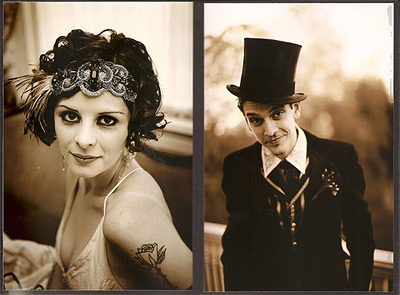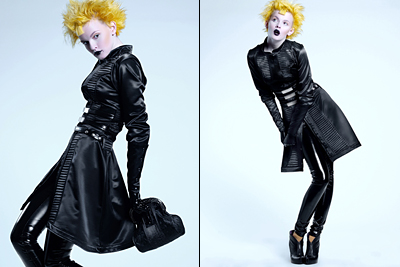
Mario, a magician, and his assistant, Katie, have a 1920s-themed wedding. Kate wears a headband bought on Etsy. Photos by Daria Bishop. More images here.
In Junior High, our Health class had a unit about “basic adult life skills”: how to pay your bills, how your car works & why you really do need health insurance, despite the fact that you think you’re indestructible. One of the final projects we had that quarter was to budget out $30,000 in one of two ways: it was to be either your funds for one year of single living, or your budget to plan a wedding. The teachers assigned this without irony, and kids took it very seriously: it was not a lesson to show us how excessive the average wedding seems when you consider how else the money could be spent, but a lesson in how a proper American wedding was to be done. I was horrified. Years later, the following passage from The Commitment, Dan Savage’s gay-marriage memoir, summed up my perception of The Great American Wedding perfectly. In the scene below, Savage and his boyfriend Terry find themselves at a wedding expo:
Each and every vendor, from the lowliest florist to the highest-end caterer, was selling the fairy-tale princess wedding, the wedding that almost all straight girls grow up fantasizing about. For the women in the room, this was their one and only chance to be the princess in the Disney movie and they were determined not to fuck it up – and “it” refers to the ceremony and the reception, not the choice of a mate, as divorce rates would seem to indicate. (The wedding industry rakes in billions annually at a time when one out of every two marriages ends in divorce. Isn’t it about time some trial lawyers slapped Brides magazine, Vera Wang, and the rest of “big marriage” with a class action lawsuit modeled on the ones filed against big tobacco?)
Back to the boys: As we worked out way up and down the rows of vendors, I caught sight of the same guys again and again. Every time their fiancées or future mothers-in-law looked away, the boys would send out subtle distress signals, like a kidnap victim in a ransom video, blinking messages in Morse code. “Oh my god, what have I done?” As they were dragged from florist to caterer to limo, they looked like pawns. No, it was worse than that: They looked like hostages. No, worse still: they looked like afterthoughts. You don’t need men to have weddings! You need women and their mothers and sisters and their best friends and container ships full of machine-made lace from China and towering ice sculptures and enormous white canvas tents and karaoke machines and stretch Hummer limos and bouquets and chocolate fountains and cover bands and garter belts and veils and trains and engraved champagne glasses and sterling silver cake knives and on and on and on … you need a boy at a wedding like you need a stalk of celery in a Bloody Mary: It looks nice, and it makes things official, but it’s not crucial and probably wouldn’t be missed if you left it out. But a wedding – as currently understood, practiced, and marketed in America – without a bride? Unthinkable.

Clockwise from left: pink-haired bride, casual Arkansas wedding, Lucifire & Dave Tusk’s bright red circus wedding, Han Solo & Leia cake topper
There are, of course, other ways to go, especially this year. More and more people are opting for crafty, creative weddings that either twist around the tired tiara-and-lace tropes, or toss them out altogether. And on the site Offbeat Bride, the Wedding Porn section chronicles the most unusual, inspiring weddings ever to be documented on the web.
These are the weddings of our generation: pixelated 8-bit wedding invites, space helmets, brides as officants, a special category on the blog just for black wedding dresses, a San Francisco bike wedding, and, of course “Wedding! The Musical.” There’s enough love and joy on this site to make you queasy if you’re in a “only stupid people have good relationships” kind of mood, but even then, something on the site will make you smile. Like these Lego cake toppers, for instance.





















